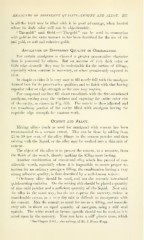Page 369 - My FlipBook
P. 369
AMALGAMS OF DIFFERENT QUALITY—CEMENT AND ALLOY. 367
in all the teeth may be filled with it to good advantage, when located
where its dark color will not be objectionable.
—
"Tin-gold" and Gold. "Tin-gold" can be used in connection
with gold in the same manner as has been described for the use of tin
and gold, or soft and cohesive golds.
Amalgams of Different Quality in Combination.
For certain amalgams is claimed a greater preservative character
than is possessed by others. But on account of very dark color or
little edge strength ^ they may be undesirable for the surface of fillings,
especially wdien contour is necessary, or when prominently exposed to
view.
In simple cavities it is very easy to fill nearly full with the amalgam
deemed best for its preservative qualities, and to finish with that having
superior color or edge strength as the case may require.
For compound cavities fill about tAvo-thirds with the first-mentioned
amalgam, cutting away the surfaces and exposing the entire outer rim
of the cavity, as shown in Fig. 336. The matrix is then adjusted and
the remaining portion of the cavity filled with amalgam having the
requisite edge strength for contour work.
Cement and Alloy.
Mixing alloys (such as used for amalgam) with cement has been
recommended to a certain extent. This can be done by adding from
25 to 50 per cent, of the alloy filings to the cement powder and then
mixing with the liquid, or the alloy may be worked into a thin mix of
cement.
The object of the alloy is to protect the cement, in a measure, from
the fluids of the mouth, thereby making the filling more lasting.
Another combination of cement and alloy which has proved of con-
siderable worth, especially where it is impossible to secure proper re-
tention for an ordinary amalgam filling, the combination having a very
strong adhesive quality, is thus described by a well-known writer:
" Ordinary alloy should be used, and not the recently introduced
quick-setting varieties. On the mixing slab should be placed a quantity
of zinc oxid powder and a sufficient quantity of the liquid. Now mix
the alloy in the usual way, but do not express the mercury, unless in
considerable excess, as a very dry mix is difficult to incorporate with
the cement. Mix the cement as usual for use as a filling, and immedi-
ately mix in about an equal quantity of amalgam, using a stiff steel
spatula. The white metal or bronze spatula should not be used, as it is
acted upon by the mercury. Now you have a stiff plastic mass, which
^ See Chapter XIII. ; also writings of Dr. J. Foster Flagg.


